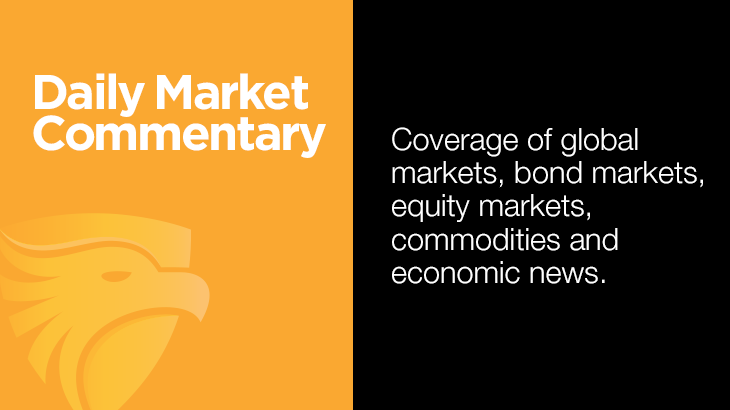Stocks rallied on Wednesday as the Financial Times reported that the UAE will call upon OPEC to increase production. Confused? This comes a day after OPEC leaders Saudi Arabia and the UAE declined discussions with Joe Biden to release more oil. OPEC has the ability to release significant amounts of oil and push oil prices lower. The question is what will OPEC demand in exchange? The discussion is relevant for investors as the price of oil and the stock market have been inversely correlated this year. This is occurring because higher oil prices drive inflation worries which in turn puts pressure on the Fed to remove liquidity quicker. The graph below shows the inverse correlation has persisted since November.
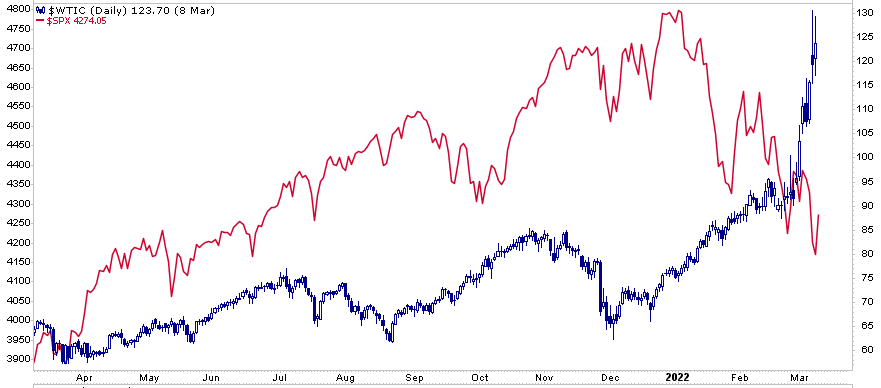
[dmc]
What To Watch Today
Economy
- 8:30 a.m. ET: Consumer Price Index month-over-month, February (0.8% expected, 0.6% in January)
- 8:30 a.m. ET: CPI excluding food and energy month-over-month, February (0.5% expected, 0.6%. in January)
- 8:30 a.m. ET: CPI year-over-year, February (7.9% expected, 7.5% in January)
- 8:30 a.m. ET: CPI excluding food and energy year-over-year, February (6.4% expected, 6.0% in January)
- 8:30 a.m. ET: CPI Index NSA, February (283.7 expected, 281.12 in January)
- 8:30 a.m. ET: CPI Core Index NSA, February (289.5 expected, 286.43 in January)
- 8:30 a.m. ET: Real average hourly earnings, February (-1.7% prior, revised to -1.8%)
- 8:30 a.m. ET: Real average weekly earnings, February (-3.1% prior, revised to -3.0%)
- 8:30 a.m. ET: Initial jobless claims, week ended March 5 (217,000 expected, 215,000 during prior week)
- 8:30 a.m. ET: Continuing claims, week ended February 26 (1.450 million during prior week)
- 12:00 p.m. ET: Household change in net worth, 4Q ($2.4 trillion in 3Q)
- 4:00 p.m. ET: Monthly budget statement, February (-$212.0 billion in February, $310.9 billion in January)
Earnings
Post-market
- DocuSign (DOCU) to report adjusted earnings of $0.48 on revenue of $561.65 million
- Rivian (RIVN) to report an adjusted loss of $1.97 on revenue of $63.96 million
- Oracle (ORCL) to report adjusted earnings of $1.18 on revenue of $10.51 billion
- Ulta Beauty (ULTA) to report adjusted earnings of $4.61 on revenue of $2.70 billion
Market Surges On Short-Squeeze
Yesterday, the market surged on news OPEC will increase production which killed oil stocks and boosted beaten-down growth stocks. We have seen the short-squeezes previously that tend to fail at the declining 20-dma (red line).
As noted yesterday morning, the rally was not unexpected but does little to change our current positioning. A rally back to resistance will be an opportunity to reduce and rebalance risk heading into the Fed meeting next week. However, if the market should muster a rally above the downtrend line, then the 50-dma becomes the next logical target. Trade accordingly.
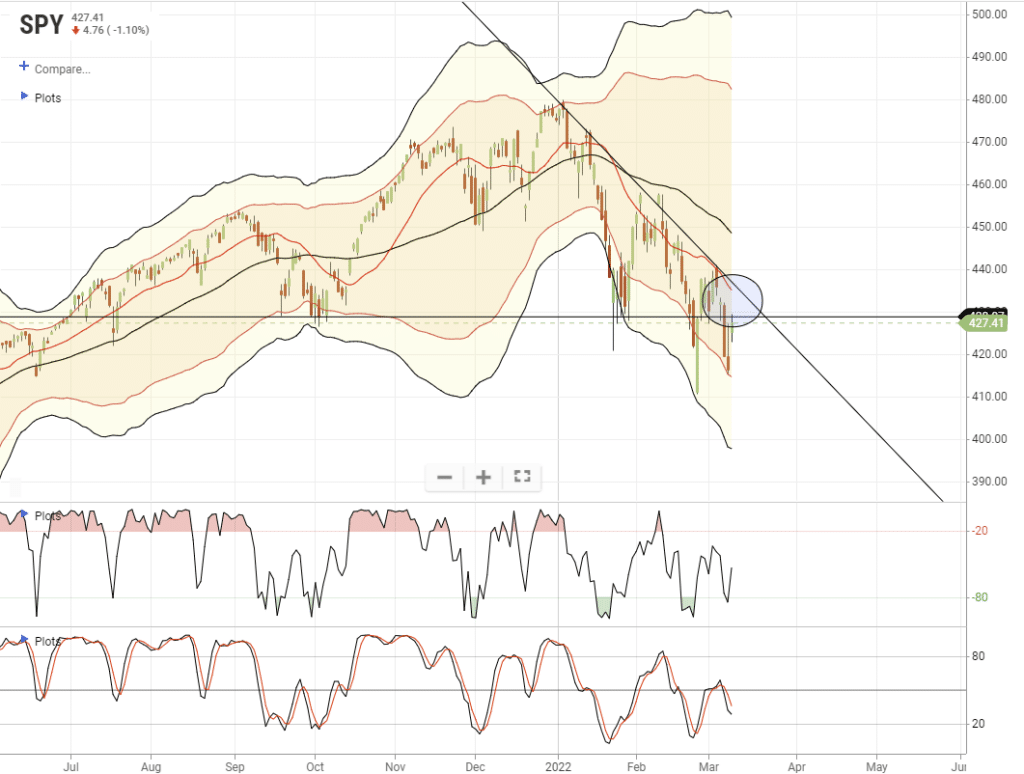
Market Rallies After 10% Corrections
In yesterday’s Fox Business interview with Charles Payne, I discussed a recent historical chart showing how markets act after 10% corrections. The difference between a rally to new highs and a rally that leads to new lows is whether or not a recession is present. Chart below.
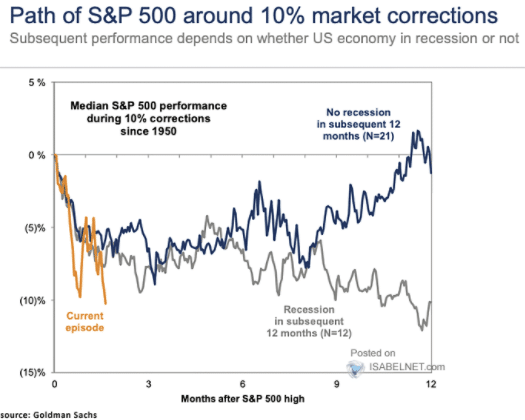
Energy Outperformance Won’t Last
Over the last couple of weeks, we discussed the need to take profits in energy stocks as the current outperformance will not last indefinitely. Yesterday, we saw what that reversion can look like on just a single OPEC headline.
“US stock markets aren’t having a good start to the year. In the S&P 500 index — which oddly actually has 505 members — 131 stocks are in the green in 2022, compared to 374 in the red. Among the worst performing stocks are some big names including Netflix (down 42%), Meta (-44%), Moderna (-50%) and PayPal (-50%).
All told the index itself is down a little over 13% this year, with every single sector in the red — except energy, which is now up 40% for the year thanks to rising oil and gas prices.” – Chartr
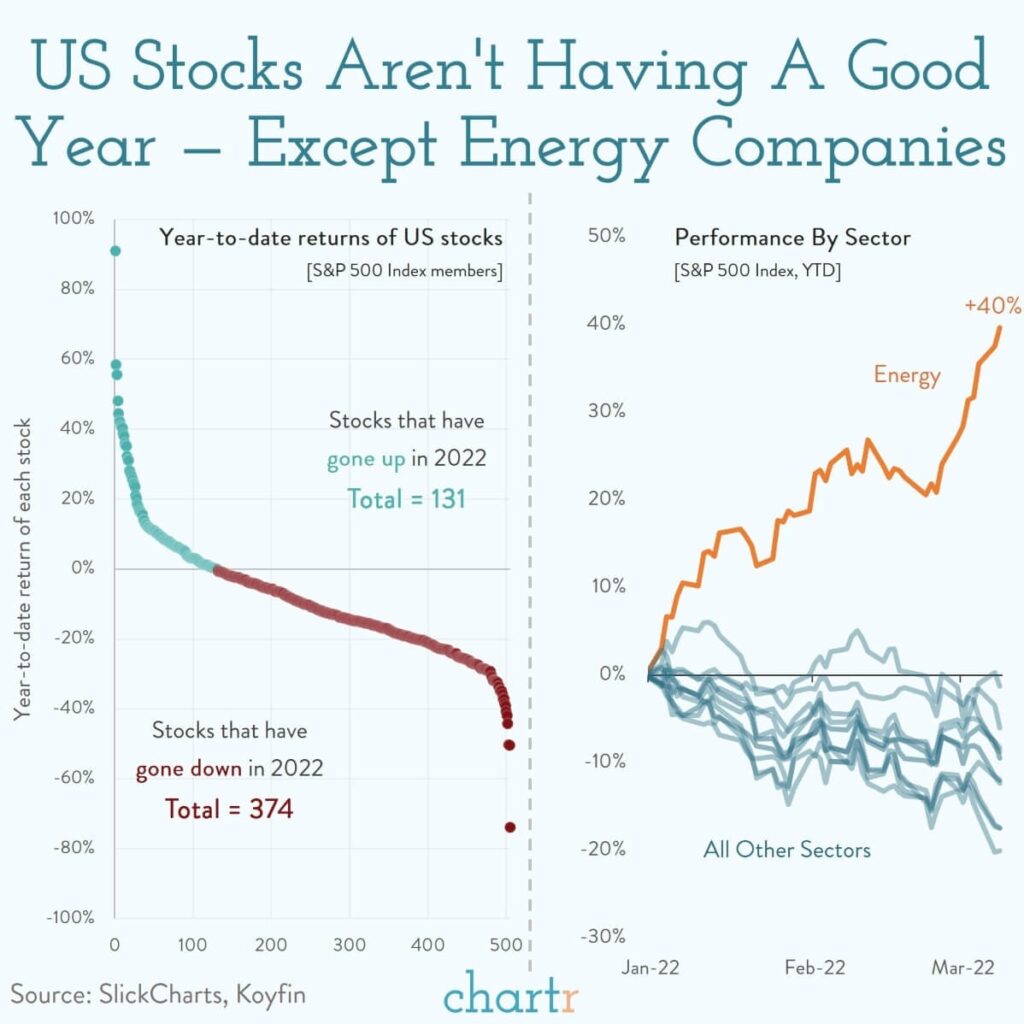
Outperformance like this is great while it lasts, but what is “hated today” will eventually be “loved tomorrow.” While in the short term OPEC headlines matter, in the longer term it will be recessionary forces that matter most.
Don’t forget to take profits along the way.
The Coming Fed Quandry
The Fed considers market-implied inflation rates, as shown below, a key predictor of inflation. Inflation expectations have taken another leg higher over the last couple of months. If the Fed ignores this gauge of expected inflation and decides to take a less hawkish tack at the coming FOMC meeting, inflation expectations could rise sharply. In that event, bond investors are likely to think the Fed is not doing enough to quell inflation. Bond yields would follow expectations higher.
While the stock market may initially cheer a less hawkish Fed, they may in time realize rising inflation expectations are bad for stock prices. If, instead, the Fed decides to be aggressive, possibly raising rates by 50bps or employing hawkish language, bond yields may fall, and implied inflation expectations may drop as well. However, stock investors may also fret because the Fed is removing liquidity from the financial markets too quickly? The Fed has quite the needle to thread next week.

JOLTS
The JOLTS report, like last week’s employment reports, point to further tightness in the labor markets and as such upward pressure on wages. Job vacancies were 11.263 million, higher than last months 10.925 million. However, last month was revised much higher to 11.448 million. The Quits rate dipped from 3% to 2.8%.
Will Higher Gas Prices Push Consumers To Buy Electric Vehicles (EVs)?
Tracy Shuchart (@Chigrl) is an energy trader and strategist we follow closely. During the recent surge in oil prices, she has been a great source of information, helping us better understand the complex macro and micro dynamics driving oil prices. To that end, she recently put out an enlightening thread pointing out the flaw in assuming that higher oil prices will push people toward EVs. Here it goes:
- The mining industry has the same lack of CAPEX problem over the last 7 years that oil does-creating a huge supply deficit
- As demand increases for these vehicles, thus does the need for more of these metals
- EVs require significantly more metal than ICE vehicles. For example, an ICE vehicle requires 18-49 lbs of copper, whereas an EV requires 189 lbs -that does not even include the battery
- Metals needed for EV’s, batteries, and charging stations are already surging to new highs. This adds to the cost of production for these vehicles…meaning higher costs to the customer
- Higher fossil fuel costs also mean higher charging prices
- Back to mining. Mining is VERY energy-intensive. We are going to need a lot of fossil fuels to mine more metals. Higher oil prices mean higher costs to mining, thus higher metals prices. Thus higher prices to the consumer
Bottom line, higher energy prices result in higher EV prices. In Tracy’s words: “Its circular…that is what people are missing”
Russian Exports Suspended- Got Palladium?
On Tuesday Russia suspended all exports of raw materials and products throughout the year. Nickel, wheat, and oil have been surging due to sanctions on Russia and lost supply of these goods due to the war. The Bloomberg graph below charts Russian exports of critical commodities as a percentage of global production. Palladium stands out on the graph, with Russia supplying half of the world’s output. Most palladium is used for catalytic converters in cars. As we have seen with semiconductor chips, a curtailment of palladium supply may extend the shortage of new cars. The second graph shows palladium just hit a 20+ year high.
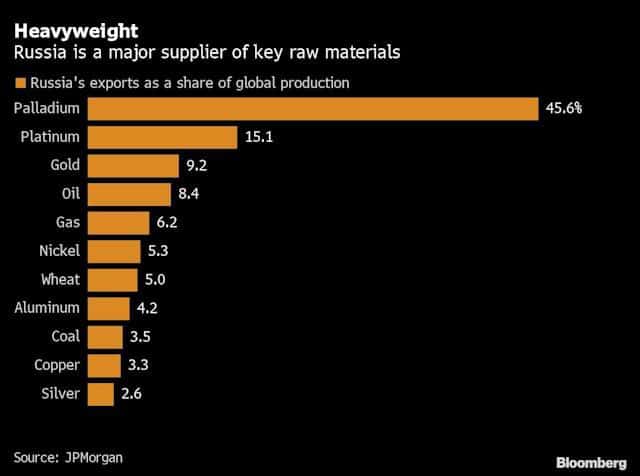

Please subscribe to the daily commentary to receive these updates every morning before the opening bell.
